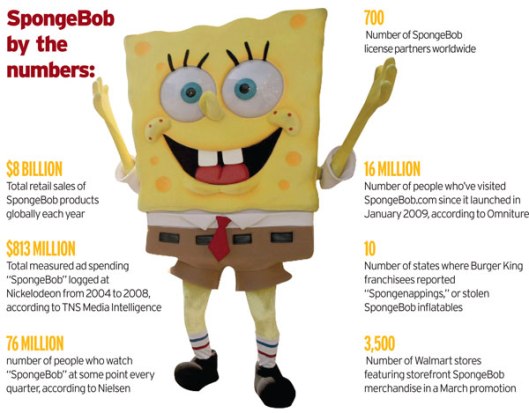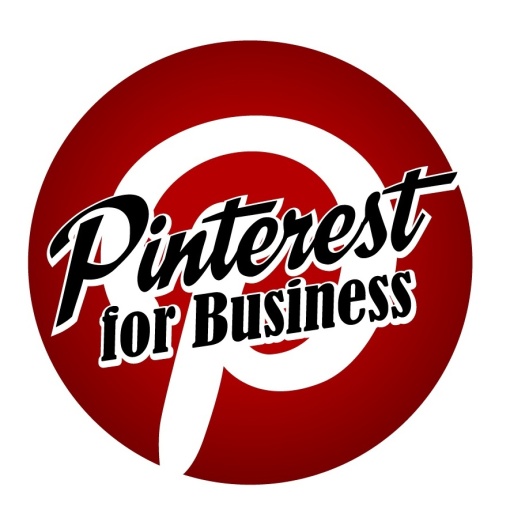Earlier this semester I had blogged about advertising and children. I wrote about how children are the new focus of marketing campaigns. This topic has been reoccurring for me this semester in one of my graduate seminar courses.
McDonald’s and it’s golden arches have stood out among the sea of fast food entities and has much success over the years in marketing towards children.
Another prime example of a brand with successful marketing and branding tactics directed at children is SpongeBob SquarePants. SpongeBob, created by American marine biologist, Stephen McDannell Hillenburg, celebrated his 10th birthday in 2009. This is a milestone that very few characters on television have a chance to celebrate (Hampp, 2001). Far beyond his success and longevity on television, SpongeBob has grown into an $8 billion dollar a year retail for Nickelodeon. There are more than 700 license partners worldwide (Hampp, 2009).
Marketers associate the products and activities they want to sell with entertaining characters to increase interest in those products. Successful marketing campaigns use branded characters to appeal to children and youth. Rights to use popular television characters, like Nickelodeon’s SpongeBob SquarePants, help sell a variety of products. For example, SpongeBob can be found just about anywhere: Colgate Toothpaste, Nickelodeon Suite Resorts in Florida, clothing, cereal, Kraft Mac & Cheese, and Vtech and Leapster Computers. That little yellow sponge is everywhere!
Marketers associate the products and activities they want to sell with entertaining characters to increase interest in those products. They use the same characters in online marketing campaigns and in television advertisements
Emotional connections are built with children in mind by capturing their hearts and minds through characters on TV. Cartoon and licensed characters are a highly successful marketing strategy when it comes to children. Using SpongeBob to endorse products consistently keeps children engaged through themed toys, clothing, accessories, movies, television programs, video games, and countless other consumer goods. Products traditionally purchased by adults such as food, travel, and clothing are now being marketed to children. Although children have been targets for advertising since the advent of mass marketing, the intensity and frequency of children’s current exposure to commercial messages is unprecedented.
Popular, well-known characters and celebrities are used to build marketing campaigns using psychology principles that persuade children they need a product and in the process convince their parents to purchase it. As well, advertisers use characters and celebrities from shows like SpongeBob SquarePants to successfully reel in children. Marketing SpongeBob to children aids in the start of the consumer socialization process at a very young age. This is the start of the process where parents and marketing build the foundation for creating consumers at a very young age.
American children are bombarded with messages from advertisers beginning at a very young age. Many advertisements that are directed towards children focus on familiarizing them with engaging characters. This type of advertising has proven extremely effective, as children show excellent recall and recognition for characters seen in ads.
With the success of engaging children with television characters and in turn having those characters present messages about products, there is a level of familiarity or comfort. Children ages eight to ten show excellent recall and recognition for characters seen in advertisements and through adults, both becoming familiar sources of trust (Danovitch, 2010). With this familiarity, children are able connect with these characters and easily desire to be a part of anything SpongeBob has to offer.
SpongeBob’s marketing successes have gone beyond selling toothpaste and t-shirts. Successes have moved into the entertainment education arena. There is an integration of education content into entertainment vehicles for children. With the trust factor guiding the integrated marketing process there are Internet games intertwined with education content. Marketers are increasingly building brand awareness and loyalty through video games. To some the notion of using cartoon characters like SpongeBob, causes some to cringe, while others support it. Regardless of the many views towards using games and entertainment as part of education, television and cartoon characters have found their niche in the education world. Understanding and awareness that there is a built-in market appeal for characters such as SpongeBob, Rug Rats, Sesame Street, McDonald’s and their ability to stand out on a shelf among other education offerings is a key component for marketers. The focus remains on the mechanism and marketing, rather than the content of such products. Websites sponsored by Nickelodeon leading the pack for education interlaced with the Spongebob name. Aside from various SpongeBob interactive educational websites, Leapster and Vtech Computer have jumped on this education bandwagon as well.
There is a lack of healthy skepticism when it comes to edutainment regarding education. This is especially true with children who immediately relate and connect with the character connected with the interactive game or product. Often times this type of educational entertainment is viewed as purely play and insufficient in terms of actual learning taking place. There are various views regarding on the level of learning that takes place, implying the level of engagement is strictly with the branded SpongeBob character.
Children are vulnerable to marketing because they lack the cognitive skills to understand the persuasive intent of television and online advertisements. The new stealth techniques can undermine the consumer defenses of older children and adolescents. Today, children live and grow up in highly sophisticated marketing environments that influence their preferences and behaviors. Using SpongeBob and other well-known brand characters to promote, enhance, and encourage entertainment as part of education has proven successful in many arenas.

http://adage.com/article/media/nickelodeon-s-spongebob-8b-kid-franchise/137866/






